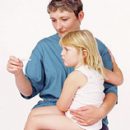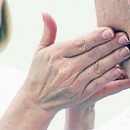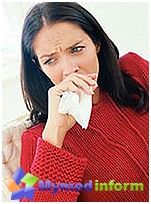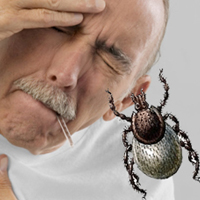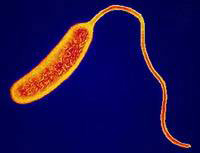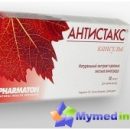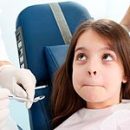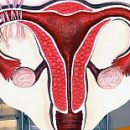This is an acute inflammatory disease of the gastrointestinal tract, the pathogens of which are the bacteria of Schigella (Shigella). What do we know about dysentery?
Content
Acquaintance with dysentery
Shame Mom, who did not wash the kid handles after fun games on the street, in the sandbox! Under the nails, the crumbs necessarily remained dirt and sand, in which Schigellas are quietly sitting. These bacteria can penetrate the child's body even through the toys with which he played outside the house or in the company. In addition, ordinary flies can become carriers of pathogens of dysentery.
Infection can occur through contaminated water or food, items that touched the patient with dysentery, through vegetables and fruits, which ever feasured by the feces of birds, animals or even people.
Dieseneria is serious
So, unexpectedly - microbes got into the child's body. Incubation period of dysentery from 2 to 10 days. After that and crumb, and mom will have a lot of serious tests.
At the beginning of the disease, the body temperature is usually increased to 38-39°C (in severe cases up to 41°C), abdominal pain appear. The child disappears appetite, it is possible. There is a frequent liquid chair, up to 10-20 times a day, with an admixture of mucus and blood, then it acquires the kind of grayish-green mucous lumps with streaks of blood. The patient child may have false cue for defecation, not bringing relief, often causing pain.
Dieseneria has symptoms of poisoning - headache, neck muscle tension, inhibition. High temperature can cause nonsense. The danger of the disease consists in the fact that a frequent liquid chair leads to dehydration of the body, so try to fill the lack of fluid in the child's body.
Dieseneria can be different
The duration of the disease of dysentery depends on the nature of the disease and the degree of infection. Distinguish the light shape of dysentery and heavy. Light forms of dysentery torment a child to one and a half weeks. The temperature is increasing slightly, the appetite is preserved, the defecation of Nonbabolene. The main symptom of the disease in this case is frequent (4-5 times a day) a stool with an admixture of mucus. The heavy form is accompanied by a very high temperature, strong vomiting and diarrhea.
Doctors distinguish this disease and duration - acute dysentery, protracted and chronic. No more than a month may need a child to recover after its acute form. The protracted disease lasts from one to several months, and chronic - years! Two latter types of dysentery can often occur due to improper treatment of this disease. Therefore, as soon as you notice the symptoms of infection, contact the qualified specialists immediately.
There are cases when symptoms of dysentery are not observed, but the microbes still live in the intestine of the kid. They are in a kind «Commonwealth» with bacteria normal intestinal flora. Since other children can be infected from the child - the carrier of dysentery, the path to children's institutions is closed to it. Therefore, it is important for any abnormalities in the work of the gastrointestinal tract to treat high quality and in the shortest possible time.
How to help with dysentery
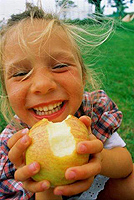 When the first symptoms of the disease, call the doctor to the house. Be sure to save in the jar of calming, so that the doctor can inspect it. Before the arrival of the doctor, do not give the child any drugs from diarrhea. But if you are away from a medical institution, a child can help the child «Furazolidon» in the dose indicated in annotation.
When the first symptoms of the disease, call the doctor to the house. Be sure to save in the jar of calming, so that the doctor can inspect it. Before the arrival of the doctor, do not give the child any drugs from diarrhea. But if you are away from a medical institution, a child can help the child «Furazolidon» in the dose indicated in annotation.
The baby needs to pass tests on dysbacteriosis and the presence of Schigell bacteria. Treatment of dysentery is usually carried out using antibacterial drugs (antibiotics). In case of individual intolerance of antibiotics, the doctor may appoint other treatment.
Effective treatment of dysentery takes place in the hospital, but with light forms of the disease (if there is no high temperature, dehydration or strong intoxication) can be at home. However, the doctor daily or every other day should visit the patient.
Be sure to disinfect the room where the child was or is. Paul must be flushed by 1% chlorine solution. Competitive and bedding first need to boil with a disinfectant, and then wash. The pot and toilet should be treated with 10-20% solution of chlorine lime, toys soak up for 30 minutes in a 2% solution of chlorine, then rinse thoroughly with water.
It is necessary to disinfect all items and surfaces with which the kid had or will have contact. Just do not overdo it with «Chemistry» And wash everything thoroughly with clean water. Such procedures do not necessarily hold daily.
Do not forget to wash your hands
How to protect the body of the kid from bacteria and avoid serious gastrointestinal diseases? The answer is simple: after a walk, toilet and before each meal I washing the hands of a baby with ordinary baby soap.
According to studies of American scientists, some types of soap with so-called antibacterial components are really killed by microbes, but over time they acquire persistent immunity to these components and are not destroyed. So the usual baby soap is quite suitable for the daily toilet.
To remove microbes with vegetables and fruits, thoroughly rinse them in cold running water. Water for drinking need to be boiled for 3-5 minutes.
Remind the child that there are dirty vegetables, fruits and berries are very harmful, drinking not boiled water from under the tap or from the stream is dangerous, and take the hands of the caramel's hands just in disabilities.

